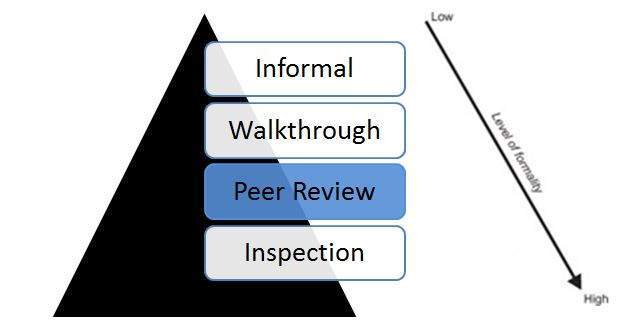
Software Testing - Peer Review
Software is reviewed in multiple ways to minimize the chances of human error, and to improve its quality. A review is a very important part of the software development lifecycle (SDLC). The software peer review is the process in which the peers in the team verifies each others work.
What is Software Peer Review?
The software peer review is the process of reviewing the code of fellow developers. It also includes verifying the test cases developed by the team mates to provide necessary feedback, and to minimize the problems faced during the testing phases.
The software peer review involves going through, and verifying the code or test cases to confirm if they are developed correctly as per the requirements. It detects the probable misses, provides suggestions, and also validates whether they are developed as per the compliances, and standards. It is a very helpful process of getting various viewpoints on an individuals work. Thus it adds perfection to the deliverables, and makes it more easily understandable.
The software peer review is considered as static black box testing. The static testing refers to checking the code or testing related documents without actually executing the code. The items which are the part of the static testing method are listed below −
- Requirement specification documents
- Design and architecture documents
- Website content
- Program Source Code
- Test plans, cases, scenarios, scripts, and data
- User requirement documents
The software peer review process becomes more formal as it moves down the pyramid. The various stages of peer review involve the informal, walkthrough, peer review, and inspection.

Why do we do the Software Peer Review?
The software peer review is done for the reasons listed below −
- The curious mind set of the fellow developers, and testers help to find discrepancies which might have been missed from our eyes.
- The software peer review helps to improve the communication, and collaboration within the team as everyone is aware of the assigned roles and responsibilities of every team member. It aids in the knowledge sharing within the team.
- The software peer review encourages an environment of healthy competition within the team.
- The software peer review saves the cost of review carried on by the external teams or by using automation review tools.
- The software peer review helps the developers, and testers to meet the deadlines for their deliverables by taking the help from fellow team mates.
What Should be Part of Software Peer Review?
The items which are the part of the software peer review are listed below −
- The software definition, and marketing planning document are reviewed to evaluate the aim, and objectives of the software.
- The software requirements, and specifications are reviewed to verify the end user needs of the software.
- The software design documents such as system architecture, and UI/UX are the part of the software peer review process.
- The software review process involves verifying the code for the backend to identify defects, areas of improvement etc.
- The software review process involves verifying the test plans, test cases, test scenarios etc.
Types of Software Peer Review
The different types of the software peer review are listed below −
1. Formal
It is conducted by a trained moderator, and has a defined structure. It consists of a series of steps including the requirement walkthroughs, technical reviews, inspections, and going through the reports.
2. Informal
It is not conducted by a moderator and is done on the basis of personal requests from team members. It does not include a systematic approach, and has no documentations, and recordings of the entire process.
Process of Software Peer Review
The process of the software peer review process are listed below −
Step 1 − Begin with the informal review process so that the code or the test cases are reviewed to detect errors, and areas of improvements.
Step 2 − Next step is to walk through the code or the test case, and to identify the flaws.
Step 3 − The formal review process is kicked off by following a methodical approach, and is led by a moderator.
Step 4 − The complete review process consists of the formal, and informal approaches.
Step 5 − Several testing metrics or techniques are used to evaluate the outcome of the review process, and to analyze its effectiveness.
Characteristics of Software Peer Review
The characteristics of the software peer review process are listed below −
- The software review process is a documented way of analyzing the code to detect the defects in it.
- The senior management is not involved in the software review process. It consists of the peers, and other technical members in the team.
- The software review process is guided by a moderator who is not the author of the code or the test case.
- The reviewers come up with the final review report illustrating the discrepancies, and areas for improvement.
Conclusion
This concludes our comprehensive take on the tutorial on Software Peer Review. Weve started with describing what is software peer review, why do we do the software peer review, what are the different types of the software technical review, what should be the part of the software peer review, what are the different types of the software peer review, what is the process of the software peer review, and what are the characteristics of the software peer review. This equips you with in-depth knowledge of the Software Peer Review. It is wise to keep practicing what youve learned and exploring others relevant to Software Testing to deepen your understanding and expand your horizons.